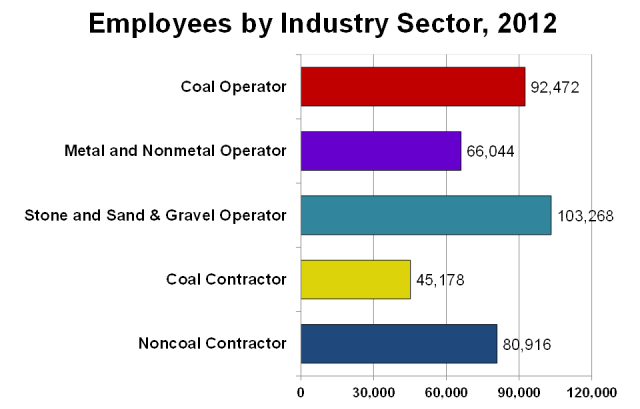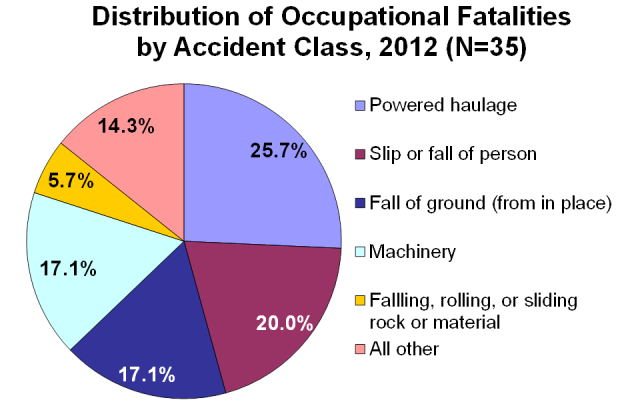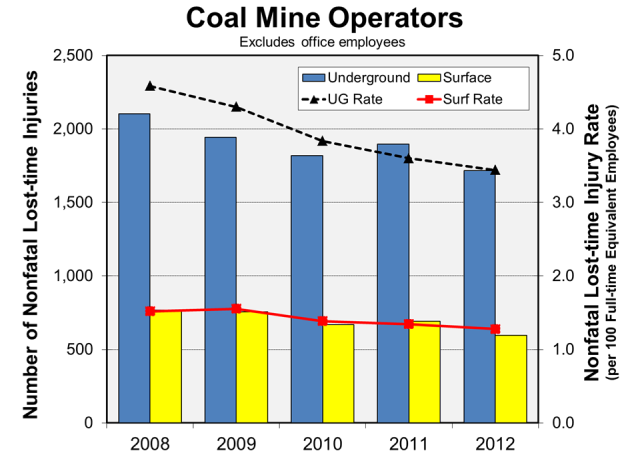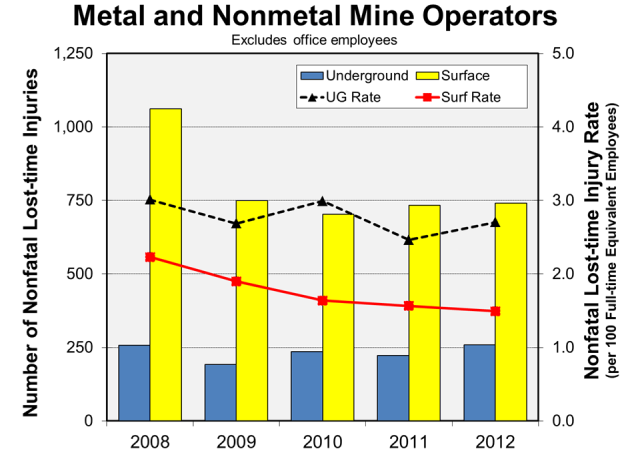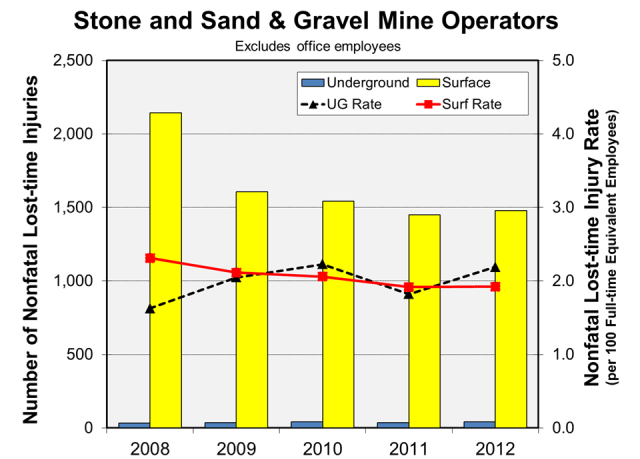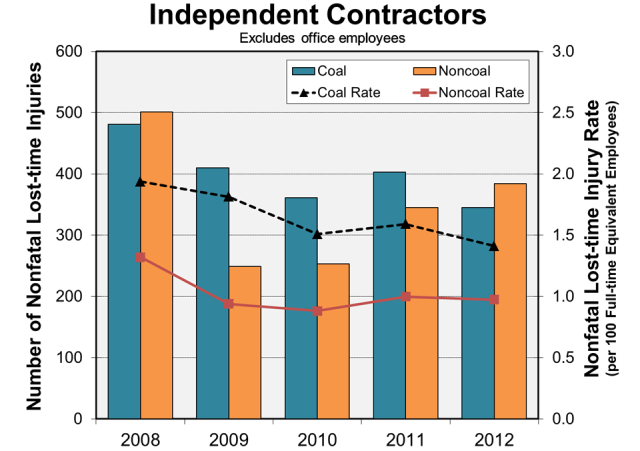Mining Facts - 2012
Overall Mining
The Mine Safety and Health Administration (MSHA) maintains data collected under the Code of Federal Regulations (30 CFR Part 50) on accidents, fatal and nonfatal injuries, illnesses, employment, and coal production. Summary data were obtained from the MSHA data files for mine operators and independent contractors working on mine property. See Statistical Methodology for further information.
Mining Operations
- In 2012, a total of 14,093 mining operations [1] reported employment to MSHA.
- Active mining operations were distributed among the coal (n=1,871; 13.3%), metal and nonmetal (n=992; 7.0%), and stone and sand & gravel (n=11,230; 79.7%) industry sectors. [2]
- The majority of the active mining operations were classified as surface (n=13,256; 94.1%). Underground mines accounted for the remainder of operations (n=837; 5.9%).
- Nearly half (48.2%) of the mining operations produce the primary commodity of sand & gravel, followed by crushed and broken limestone (13.8%), and bituminous coal (12.2%).
- Mines reporting to MSHA are located in all 50 states, Puerto Rico, and the Virgin Islands. Pennsylvania had the most mines (n=920; 6.5%) followed by Texas (n=723; 5.1%). Almost half (49.0%) of the active mining operations are located in the 13 topmost states.
Click on the image to enlarge.
Data for the previous chart showing the number of active mining operations and percent of total by commodity in 2012 (N=14,093)
| Commodity | Number of Mines | Percent of Total |
|---|---|---|
| Coal | 1,871 | 13 |
| Metal | 351 | 3 |
| Nonmetal | 641 | 5 |
| Stone | 4,433 | 31 |
| Sand & Gravel | 6,797 | 48 |
Employees
- A total of 387,878 employees, [3] corresponding to 327,192 full-time equivalent (FTE) [4] employees, were reported to MSHA by mine operators and independent contractors. [5]
- Within the mining commodities, [6] coal mine operator employees accounted for 30.5% of all employee hours reported, followed by stone operators (19.4%), metal operators (14.1%), noncoal contractors (12.8%), sand & gravel operators (8.7%), coal contractors (7.9%), and nonmetal operators (6.6%).
- The FTE employees reported for surface [7] work locations were higher (259,068; 79.2%) than those at underground work locations (n=68,124; 20.8%).
- The average number of mine operator employees comprised 67.5% of the workforce compared to 32.5% for independent contractors.
- The distribution of employees by industry sector included coal operators (n=92,472; 23.8%), metal and nonmetal operators (n=66,044; 17.0%), stone and sand & gravel operators (n=103,268; 26.6%), coal contractors (n=45,178; 11.6%), and noncoal contractors (n=80,916; 20.9%).
Click on the image to enlarge.
Data for the previous chart showing the average number of employees by industry sector in 2012
| Industry Sector | Number of Employees |
|---|---|
| Coal Operator | 92,472 |
| Metal and Nonmetal Operator | 66,044 |
| Stone and Sand & Gravel Operator | 103,268 |
| Coal Contractor | 45,178 |
| Noncoal Contractor | 80,916 |
Occupational Fatalities
- There were 35 occupational fatalities reported to MSHA in 2012. This compares to 37 in 2011.
- Fatalities occurred at surface work locations in 54.3% of the cases (n=19) with the remainder (n=16; 45.7%) occurring at underground work locations.
- The fatality rate was 11.7 [95% confidence interval (CI): 8.2, 16.3] per 100,000 FTE employees.
- The highest number of fatalities reported by accident classification were for powered haulage (n=9; 25.7%) events.
- The nature of injury most frequently reported for these fatalities was multiple injuries (n=14) followed by crushing (n=10).
- Multiple body parts (n=15; 42.9%), body systems (n=6; 17.1%), and multiple trunk (n=5; 14.3%) were the parts of body most frequently reported to MSHA.
Click on the image to enlarge.
Data for the previous chart showing the number and distribution of occupational fatalities by accident class for 2012 (N=35)
| Accident Classification | Number | Percent of Total |
|---|---|---|
| Powered haulage | 9 | 25.7 |
| Slip or fall of person | 7 | 20.0 |
| Fall of ground (from in place) | 6 | 17.1 |
| Machinery | 6 | 17.1 |
| Falling, rolling, or sliding rock or material | 2 | 5.7 |
| All other | 5 | 14.3 |
Nonfatal Lost-time Injuries
- In 2012, there were 5,562 nonfatal lost-time injuries (2,202 at underground and 3,360 at surface work locations) occurring at an overall rate of 1.9 [CI: 1.8, 1.9] per 100 FTE employees.
- A total of 321,425 days were lost from work [8] as a result of these injuries.
- The nonfatal lost-time injury rate for mine operators was 2.1 per 100 FTE employees, and the independent contractor injury rate was 1.1.
- Within the industry sectors, injury rates were 2.4 for coal operators, 1.7 for metal and nonmetal operators, and 1.9 for stone and sand & gravel operators.
- The most frequent accident classification of nonfatal lost-time injuries involved handling materials (n=2,034; 36.6%), followed by slip or fall of person (n=1,366; 24.6%).
- Sprains or strains was the most frequently reported nature of injury (n=2,454; 44.1%). This was followed by injuries involving fractures and chips (n=1,007; 18.1%).
- The back was the most frequently reported body part injured (n=957; 17.2%) resulting in 56,178 days lost from work. This was followed by injuries to the finger (n=698; 12.5%; 27,606 days lost) and the knee (n=632; 11.4%; 33,581 days lost).
Click on the image to enlarge.
Data for the previous chart showing the rate (per 100 full-time equivalent employees) of nonfatal lost-time injuries by year, 2008-2012 (excludes office employees)
| Year | Overall | Operator | Contractor |
|---|---|---|---|
| 2008 | 2.4 | 2.6 | 1.6 |
| 2009 | 2.2 | 2.4 | 1.3 |
| 2010 | 2.0 | 2.2 | 1.2 |
| 2011 | 1.9 | 2.1 | 1.2 |
| 2012 | 1.9 | 2.1 | 1.1 |
Coal Mine Operator Industry Sector
Mining Operations
- In 2012, a total of 1,871 coal mining operations reported employment to MSHA.
- Bituminous mines comprised 92.1% (n=1,724) and anthracite mines 7.9% (n=147) of all coal mining operations.
- Approximately 72% of all coal mines were located in three states: Kentucky (n=521; 27.8%), West Virginia (n=437; 23.4%), and Pennsylvania (n=390; 20.8%).
Employees
- A total of 92,472 employees, corresponding to 99,881 FTE employees, were reported by coal mine operators.
- Within the mining commodity sectors, coal mine operator employees accounted for 30.5% of all employee hours reported.
- The employee hours reported for underground and surface work locations were nearly equal.
- The average number of employees at underground work locations was reported as 45,099 (48.8%) with 47,373 (51.3%) employees working at surface locations.
Occupational Fatalities
- There were 18 occupational fatalities (12 occurring underground and 6 at the surface) reported among coal mine operator employees in 2012, compared to 14 in 2011.
- The fatality rate was 18.6 [CI: 11.1, 29.5] per 100,000 FTE employees.
- The highest numbers of fatalities reported by accident classification were for fall of ground (n=4) and powered haulage (n=4) events.
- The nature of injury most frequently reported for these coal operator fatalities was crushing (n=9).
Nonfatal Lost-time Injuries
- There were 2,313 nonfatal lost-time injuries (1,717 at underground and 596 at surface work locations) among coal operators occurring at a rate of 2.4 [CI: 2.3, 2.5] per 100 FTE employees. A total of 150,928 days lost from work resulted from these injuries.
- The most frequent accident classification of nonfatal lost-time injuries for coal operator employees involved handling materials (n=772; 33.4%), followed by slip or fall of person (n=527; 22.8%).
- Sprains or strains was the most frequently reported nature of injury (n=1,034; 44.7%).
- The back was the most frequently reported body part injured (n=409; 17.7%) and accounted for 31,492 days lost from work. This was followed by injuries to the knee (n=272; 11.8%), finger (n=255; 11.0%), and shoulder (n=201; 8.7%).
Click on the image to enlarge.
Data for the previous chart showing the number and rate (per 100 full-time equivalent employees) of coal mine operator nonfatal lost-time injuries by work location and year, 2008-2012 (excludes office employees)
| Year | Underground Number | Underground Rate | Surface Number | Surface Rate |
|---|---|---|---|---|
| 2008 | 2,103 | 4.5 | 768 | 1.5 |
| 2009 | 1,943 | 4.3 | 757 | 1.6 |
| 2010 | 1,818 | 3.8 | 670 | 1.4 |
| 2011 | 1,896 | 3.6 | 691 | 1.3 |
| 2012 | 1,717 | 3.4 | 596 | 1.3 |
Metal and Nonmetal Mine Operator Industry Sector
Mining Operations
- A total of 992 metal and nonmetal mining operations reported employment to MSHA in 2012.
- Gold mines comprised the largest number of metal mining operations (n=188; 53.6%), and the highest number of nonmetal mines produced common clay (n=129; 20.1%).
- Nevada had the largest number of metal mines (n=71; 17.4%), followed by Alaska (n=54; 15.4%). The state with the most nonmetal mining operations was Texas (n=66; 10.3%).
Employees
- Metal and nonmetal mine operators reported a total of 66,044 employees, corresponding to 67,638 FTE employees.
- Within the mining commodity sectors, metal and nonmetal mine operator employees accounted for 20.7% of all employee hours reported.
- Metal and nonmetal operator hours were reported for both underground (14.2%) and surface (85.87%) work locations.
Occupational Fatalities
- There were three occupational fatalities (two occurring underground and one at a surface work location) reported among metal and nonmetal mine operator employees in 2012. This compares to four fatalities reported in 2011.
- Caution should be used when interpreting rates based on a small number of events. The fatality rate is not calculated when the number of events is less than five.
- Two fatalities had an accident classification of fall of ground (from in place), and the other fatality was reported as a slip or fall of person.
- The nature of injury for all three fatalities was reported as multiple injuries.
Nonfatal Lost-time Injuries
- There were 1,000 nonfatal lost-time injuries (259 at underground and 741 at surface work locations) among metal and nonmetal operators occurring at a rate of 1.7 [CI: 1.6, 1.8] per 100 FTE employees. A total of 56,666 days lost from work resulted from these injuries.
- The most frequent accident classification of nonfatal lost-time injuries for metal and nonmetal operator employees involved handling materials (n=369; 36.9%) followed by slip or fall of person (n=295; 29.5%).
- Sprains or strains was the most frequently reported nature of injury (n=506; 50.6%).
- The back was the most frequently reported body part injured (n=159; 15.9%) and accounted for 7,226 days lost from work. This was followed by injuries to knees (n=123; 12.3%), fingers (n=113; 11.3%), and shoulders (n=112; 11.2%).
Click on the image to enlarge.
Data for the previous chart showing the number and rate (per 100 full-time equivalent employees) of metal and nonmetal mine operator nonfatal lost-time injuries by work location and year, 2008-2012 (excludes office employees)
| Year | Underground Number | Underground Rate | Surface Number | Surface Rate |
|---|---|---|---|---|
| 2008 | 258 | 3.0 | 1,061 | 2.2 |
| 2009 | 192 | 2.7 | 750 | 1.9 |
| 2010 | 235 | 3.0 | 703 | 1.6 |
| 2011 | 223 | 2.5 | 733 | 1.6 |
| 2012 | 259 | 2.7 | 741 | 1.5 |
Stone and Sand & Gravel Mine Operator Industry Sector
Mining Operations
- A total of 11,230 stone and sand & gravel mining operations reported employee hours to MSHA.
- In stone mining, crushed and broken limestone was the primary commodity for the largest number of mining operations (n=1,946; 43.9%).
- Stone mining operations were located in all states and territories except Delaware.
- Pennsylvania had the most stone mines (n=420; 9.5%), followed by Texas (n=369; 8.3%).\
- Sand & gravel mines were found throughout all 50 states and Puerto Rico. Minnesota had the largest number of sand & gravel mines (n=506; 7.4%).
Employees
- There were 103,268 employees, corresponding to 91,814 FTE employees, reported by stone and sand & gravel mine operators.
- Within the mining commodity sectors, stone and sand & gravel mine operator employees accounted for 28.1% of all employee hours reported.
- All sand & gravel operator hours reported were for surface work locations, and stone operator hours were reported for both underground (3%) and surface (97%) work locations.
Occupational Fatalities
- In 2012, there were ten occupational fatalities reported among stone and sand & gravel mine operators, compared to five in 2011.
- Nine of these fatalities occurred at surface work areas of the mine, and one fatality occurred at an underground location.
- The fatality rate was 12.7 [CI: 6.1, 23.3] per 100,000 FTE employees.
- These fatalities had accident classifications of powered haulage (n=5); falling, rolling, or sliding rock or material (n=2); machinery (n=2); and slip or fall of person (n=1).
- The nature of injury for these fatalities was reported as asphyxia, strangulation, downing, etc. (n=3); crushing (n=1); cerebral hemorrhage (n=1); and multiple injuries (n=5).
Nonfatal Lost-time Injuries
- There were 1,520 nonfatal lost-time injuries (42 at underground and 1,478 at surface work locations) among stone and sand & gravel operators occurring at a rate of 1.9 [CI: 1.8, 2.0] per 100 FTE employees. A total of 73,178 days lost from work resulted from these injuries.
- The most frequent accident classification of nonfatal lost-time injuries for stone and sand & gravel operator employees involved handling materials (n=610; 40.1%).
- Sprains or strains was the most frequently reported nature of injury (n=639; 42.0%).
- The back was the most frequently reported body part injured (n=282; 18.6%) and accounted for 12,306 days lost from work. This was followed by injuries to fingers (n=215; 14.1%) with 6,940 days lost.
Click on the image to enlarge.
Data for the previous chart showing the number and rate (per 100 full-time equivalent employees) of stone and sand & gravel mine operator nonfatal lost-time injuries by work location and year, 2008-2012 (excludes office employees)
| Year | Underground Number | Underground Rate | Surface Number | Surface Rate |
|---|---|---|---|---|
| 2008 | 33 | 1.6 | 2,143 | 2.3 |
| 2009 | 37 | 2.0 | 1,607 | 2.1 |
| 2010 | 41 | 2.2 | 1,542 | 2.1 |
| 2011 | 35 | 1.8 | 1,451 | 1.9 |
| 2012 | 42 | 2.2 | 1,478 | 1.9 |
Coal and Noncoal Independent Contractors
An independent contractor is defined by MSHA as “any person, partnership, corporation, subsidiary of a corporation, firm, association or other organization that contracts to perform services or construction at a mine.” Contractors that perform specific types of work are required to report the number of employees who work at coal mines and noncoal mines.
Independent Contracting Companies
- A total of 10,630 independent contracting companies reported employee hours to MSHA.
- Coal contractors accounted for 3,592 of the companies (33.8%), and 7,038 (66.2%) were noncoal (metal, nonmetal, stone, and sand & gravel) contracting companies.
Employees
- Independent contractors reported a total of 126,094 employees, corresponding to 67,859 FTE employees.
- Contractor employee hours were reported for both underground (16.1%) and surface (83.9%) work locations.
- Coal contractor employees comprised 35.8% (n=45,178) of the contractor employment, and noncoal contractor employees represented 64.2% with 80,916 employees reported.
- The distribution of employee hours for coal contractors was 15.6% for underground work locations and 84.4% for surface locations.
- Noncoal contractor employee hours were reported at underground locations 6.4% of the time with 93.6% of the hours being worked at surface locations.
Occupational Fatalities
- A total of four occupational fatalities occurred among independent contractor employees. Note: No fatality rates are calculated when the number of fatalities is less than five.
- Two of these fatalities were attributed to coal contractors and two fatalities were for noncoal contractors.
- Three of these fatalities were due to slip or fall of person, and one fatality was classified as machinery-related.
- One of the fatalities occurred at an underground work location and the other three fatalities occurred at surface areas of the mine.
Nonfatal Lost-time Injuries
- There were 729 nonfatal lost-time injuries among contractor employees (184 at underground and 545 at surface work locations) with an overall rate of 1.1 [CI: 1.1, 1.1] injuries per 100 FTE employees.
- The underground nonfatal lost-time injury rate of 2.7 [CI: 2.3, 3.1] was greater than the surface injury rate of 1.0 [CI: 0.9, 1.0] per 100 FTE workers.
- Of the total injuries, 345 were attributed to coal contractors, and 384 were for noncoal contractors.
- Back injuries was the most frequently reported part of body injured for coal contractors (n=55) resulting in 3,283 days lost from work. The leading parts of body injured for noncoal contractors were fingers (n=70; 2,761 days lost) and the back (n=52; 1,871 days lost).
- Sprains or strains was the most frequently reported nature of injury for coal contractors (n=126; 36.5%) and for noncoal contractors (n=149; 38.8%).
- The leading classification of nonfatal lost-time injuries involved handling materials (n=283; 38.8%), followed by slip or fall of person (n=174; 23.9%) and machinery (n=87; 11.9%).
Click on the image to enlarge.
Data for the previous chart showing the number and rate (per 100 full-time equivalent employees) of coal and noncoal contractor lost-time injuries by year, 2008-2012 (excludes office employees)
| Year | Coal Number | Coal Rate | Noncoal Number | Noncoal Rate |
|---|---|---|---|---|
| 2008 | 481 | 1.9 | 501 | 1.3 |
| 2009 | 410 | 1.8 | 249 | 0.9 |
| 2010 | 361 | 1.5 | 253 | 0.9 |
| 2011 | 403 | 1.6 | 345 | 1.0 |
| 2012 | 345 | 1.4 | 384 | 1.0 |
Notes
Publicly released employment and accident/injury/illness data collected by the Mine Safety and Health Administration (MSHA) under the Code of Federal Regulations (30 CFR 50). All analyses of accident data exclude office employees. Occupational fatalities exclude all cases under 17 years of age. Caution should be used when interpreting rates based on a small number of events.
[1] Both mine operator and independent contractor employees work at mining operations. Active mines are those that report any mine operator employment. Mines at which only independent contractors were working and did not show any operator employment were not counted.
[2] Mining industry sectors include (1) coal, (2) metal and nonmetal, and (3) stone and sand & gravel.
[3] Average number of employees working at individual mines during calendar quarters of active operations (includes office workers).
[4] Full-time equivalent employees computed using reported employee hours (2,000 hours = 1 FTE; includes office workers).
[5] Independent contractors do not report mine-specific information for employment. The data they provide are summaries for all coal and all noncoal (metal, nonmetal, stone, and sand & gravel) mining operations. For this reason, contractors cannot be included when computing fatality and injury rates for the metal/nonmetal or stone/sand & gravel industry sectors.
[6] Mining commodity and type of employer classes include coal operators, metal operators, nonmetal operators, stone operators, sand & gravel operators, coal contractors, and noncoal (metal, nonmetal, stone, and sand & gravel) contractors.
[7] Surface work locations include surface operations at underground mines, surface operations (strip or open pit), dredge, other surface operations, independent shops and yards, and mills or preparation plants.
[8] Total days lost includes actual days away from work and/or days of restricted work activity. For permanently disabling injuries only, statutory days charged by MSHA were used if they exceeded the total lost workdays.
Data Tables
Active Mining Operations, 2012 |
|||
| Commodity | Underground | Surface | Total |
|---|---|---|---|
| Coal | 568 | 1,303 | 1,871 |
| Coal Sector | 568 | 1,303 | 1,871 |
| Metal | 117 | 234 | 351 |
| Nonmetal | 41 | 600 | 641 |
| Metal and Nonmetal Sector | 158 | 834 | 992 |
| Stone | 111 | 4,322 | 4,433 |
| Sand & Gravel | 0 | 6,797 | 6,797 |
| Stone and Sand & Gravel Sector | 111 | 11,119 | 11,230 |
| TOTAL | 837 | 13,256 | 14,093 |
Independent Contracting Companies, 2012 |
||
| Commodity | Companies | |
|---|---|---|
| Coal | 3,592 | |
| Noncoal | 7,038 | |
| Total | 10,630 | |
Employment Characteristics, 2012 |
||||||
| Commodity, Type of Employer, Industry Sector | Underground Employees | Surface Employees | Total Employees | Underground FTE Employees | Surface FTE Employees | Total FTE Employees |
|---|---|---|---|---|---|---|
| Coal Operator Sector | 45,099 | 47,373 | 92,472 | 49,897 | 49,984 | 99,881 |
| Metal Operator | 6,718 | 37,740 | 44,458 | 6,953 | 39,071 | 46,024 |
| Nonmetal Operator | 2,610 | 18,976 | 21,586 | 2,632 | 18,983 | 21,614 |
| Metal and Nonmetal Operator Sector | 9,328 | 56,716 | 66,044 | 9,584 | 58,054 | 67,638 |
| Stone Operator | 1,799 | 64,402 | 66,201 | 1,919 | 61,592 | 63,511 |
| Sand & Gravel Operator | 0 | 37,067 | 37,067 | 0 | 28,303 | 28,303 |
| Stone and Sand & Gravel Operator Sector | 1,799 | 101,469 | 103,268 | 1,919 | 89,895 | 91,814 |
| Operator Total | 56,226 | 205,558 | 261,784 | 61,401 | 197,933 | 259,333 |
| Coal Contractor | 6,244 | 38,934 | 45,178 | 4,052 | 21,853 | 25,905 |
| Noncoal Contractor | 3,502 | 77,414 | 80,916 | 2,672 | 39,282 | 41,954 |
| Contractor Total | 9,746 | 116,348 | 126,094 | 6,724 | 61,135 | 67,859 |
| TOTAL | 65,972 | 321,906 | 387,878 | 68,124 | 259,068 | 327,192 |
| Note: Components may not sum to totals due to rounding | ||||||
Occupational Fatalities, 2012Rate per 100,000 full-time equivalent employees; 95% confidence interval |
||||
| Commodity, Type of Employer, Industry Sector | Total Number | Total Rate | Total Lower CI | Total Upper CI |
|---|---|---|---|---|
| Coal Operator Sector | 18 | 18.6 | 11.1 | 29.5 |
| Metal Operator | 1 | NC | NC | NC |
| Nonmetal Operator | 2 | NC | NC | NC |
| Metal and Nonmetal Operator Sector | 3 | NC | NC | NC |
| Stone Operator | 6 | 11.1 | 4.1 | 24.1 |
| Sand & Gravel Operator | 4 | NC | NC | NC |
| Stone and Sand & Gravel Operator Sector | 10 | 12.7 | 6.1 | 23.3 |
| Operator Total | 31 | 13.2 | 9.0 | 18.8 |
| Coal Contractor | 2 | NC | NC | NC |
| Noncoal Contractor | 2 | NC | NC | NC |
| Contractor Total | 4 | NC | NC | NC |
| TOTAL | 35 | 11.7 | 8.2 | 16.3 |
| Note: NC–Not calculated when N is less than 5 | ||||
Occupational Fatalities (Underground), 2012Rate per 100,000 full-time equivalent employees; 95% confidence interval |
||||
| Commodity, Type of Employer, Industry Sector | Underground Number | Underground Rate | Underground Lower CI | Underground Upper CI |
|---|---|---|---|---|
| Coal Operator Sector | 12 | 24.0 | 12.4 | 42.0 |
| Metal Operator | 1 | NC | NC | NC |
| Nonmetal Operator | 1 | NC | NC | NC |
| Metal and Nonmetal Operator Sector | 2 | NC | NC | NC |
| Stone Operator | 1 | NC | NC | NC |
| Sand & Gravel Operator | NA | NA | NA | NA |
| Stone and Sand & Gravel Operator Sector | 1 | NC | NC | NC |
| Operator Total | 15 | 24.4 | 13.7 | 40.3 |
| Coal Contractor | 1 | NC | NC | NC |
| Noncoal Contractor | 0 | NC | NC | NC |
| Contractor Total | 1 | NC | NC | NC |
| TOTAL | 16 | 23.5 | 13.4 | 38.1 |
| Notes: NA–Not applicable; NC–Not calculated when N is less than 5 | ||||
Occupational Fatalities (Surface), 2012Rate per 100,000 full-time equivalent employees; 95% confidence interval |
||||
| Commodity, Type of Employer, Industry Sector | Surface Number | Surface Rate | Surface Lower CI | Surface Upper CI |
|---|---|---|---|---|
| Coal Operator Sector | 6 | 12.9 | 4.7 | 28.0 |
| Metal Operator | 0 | NC | NC | NC |
| Nonmetal Operator | 1 | NC | NC | NC |
| Metal and Nonmetal Operator Sector | 1 | NC | NC | NC |
| Stone Operator | 5 | 9.6 | 3.1 | 22.3 |
| Sand & Gravel Operator | 4 | NC | NC | NC |
| Stone and Sand & Gravel Operator Sector | 9 | 11.7 | 5.4 | 22.2 |
| Operator Total | 16 | 9.2 | 5.3 | 15.0 |
| Coal Contractor | 1 | NC | NC | NC |
| Noncoal Contractor | 2 | NC | NC | NC |
| Contractor Total | 3 | NC | NC | NC |
| TOTAL | 19 | 8.3 | 5.0 | 12.9 |
| Note: NC–Not calculated when N is less than 5 | ||||
Nonfatal Lost-time Injuries, 2012Rate per 100 full-time equivalent employees; 95% confidence interval |
||||
| Commodity, Type of Employer, Industry Sector | Total Number | Total Rate | Total Lower CI | Total Upper CI |
|---|---|---|---|---|
| Coal Operator Sector | 2,313 | 2.4 | 2.3 | 2.5 |
| Metal Operator | 696 | 1.7 | 1.6 | 1.8 |
| Nonmetal Operator | 304 | 1.7 | 1.5 | 1.8 |
| Metal and Nonmetal Operator Sector | 1,000 | 1.7 | 1.6 | 1.8 |
| Stone Operator | 1,141 | 2.1 | 2.0 | 2.2 |
| Sand & Gravel Operator | 379 | 1.5 | 1.4 | 1.7 |
| Stone and Sand & Gravel Operator Sector | 1,520 | 1.9 | 1.8 | 2.0 |
| Operator Total | 4,833 | 2.1 | 2.0 | 2.1 |
| Coal Contractor | 345 | 1.4 | 1.3 | 1.6 |
| Noncoal Contractor | 384 | 1.0 | 0.9 | 1.1 |
| Contractor Total | 729 | 1.1 | 1.1 | 1.2 |
| TOTAL | 5,562 | 1.9 | 1.8 | 1.9 |
Nonfatal Lost-time Injuries (Underground), 2012Rate per 100 full-time equivalent employees; 95% confidence interval |
||||
| Commodity, Type of Employer, Industry Sector | Underground Number | Underground Rate | Underground Lower CI | Underground Upper CI |
|---|---|---|---|---|
| Coal Operator Sector | 1,717 | 3.4 | 3.3 | 3.6 |
| Metal Operator | 194 | 2.8 | 2.4 | 3.2 |
| Nonmetal Operator | 65 | 2.5 | 1.9 | 3.1 |
| Metal and Nonmetal Operator Sector | 259 | 5.3 | 2.4 | 3.0 |
| Stone Operator | 42 | 2.2 | 1.6 | 3.0 |
| Sand & Gravel Operator | NA | NA | NA | NA |
| Stone and Sand & Gravel Operator Sector | 42 | 2.2 | 1.6 | 3.0 |
| Operator Total | 2,018 | 3.3 | 3.1 | 3.4 |
| Coal Contractor | 143 | 3.5 | 3.0 | 4.1 |
| Noncoal Contractor | 41 | 1.5 | 1.1 | 2.1 |
| Contractor Total | 184 | 2.7 | 2.3 | 3.1 |
| TOTAL | 2,202 | 3.2 | 3.1 | 3.4 |
| Note: NA–Not applicable | ||||
Nonfatal Lost-time Injuries (Surface), 2012Rate per 100 full-time equivalent employees; 95% confidence interval |
||||
| Commodity, Type of Employer, Industry Sector | Surface Number | Surface Rate | Surface Lower CI | Surface Upper CI |
|---|---|---|---|---|
| Coal Operator Sector | 596 | 1.3 | 1.2 | 1.4 |
| Metal Operator | 502 | 1.5 | 1.4 | 1.6 |
| Nonmetal Operator | 239 | 1.5 | 1.3 | 1.7 |
| Metal and Nonmetal Operator Sector | 741 | 1.5 | 1.4 | 1.6 |
| Stone Operator | 1,099 | 2.1 | 2.0 | 2.2 |
| Sand & Gravel Operator | 379 | 1.5 | 1.4 | 1.7 |
| Stone and Sand & Gravel Operator Sector | 1,478 | 1.9 | 1.8 | 2.0 |
| Operator Total | 2,815 | 1.6 | 1.6 | 1.7 |
| Coal Contractor | 202 | 1.0 | 0.9 | 1.1 |
| Noncoal Contractor | 343 | 0.9 | 0.8 | 1.0 |
| Contractor Total | 545 | 1.0 | 0.9 | 1.0 |
| TOTAL | 3,360 | 1.5 | 1.4 | 1.5 |
See Also
- Coal Operator Mining Facts - 2005
- Data & Statistics
- Metal Operator Mining Facts - 2002
- Metal Operator Mining Facts - 2004
- Metal Operator Mining Facts - 2005
- Mining Fact Sheets
- Noncoal Contractor Mining Facts - 2003
- Nonmetal Operator Mining Facts - 2002
- Nonmetal Operator Mining Facts - 2008
- Sand and Gravel Operator Mining Facts - 2006
- Statistical Methodology
- Stone Operator Mining Facts - 2003
- Stone Operator Mining Facts - 2005
- Page last reviewed: 5/8/2017
- Page last updated: 9/23/2015
- Content source: National Institute for Occupational Safety and Health, Mining Program


 ShareCompartir
ShareCompartir

